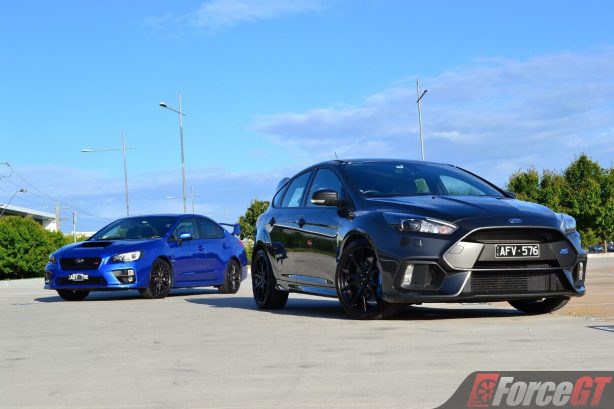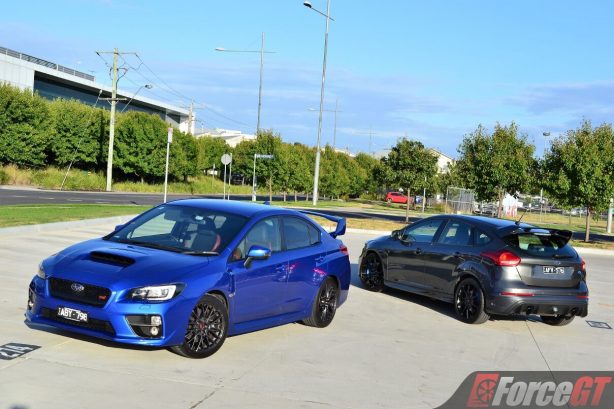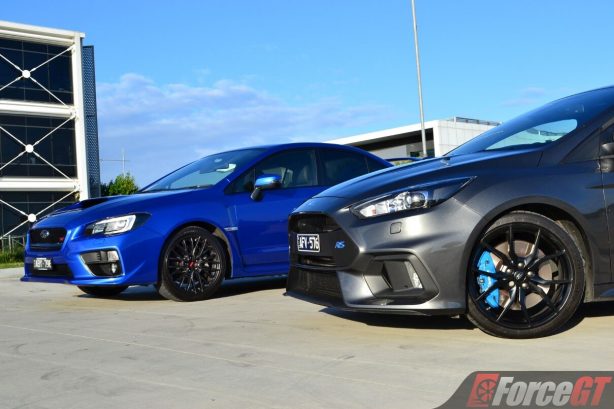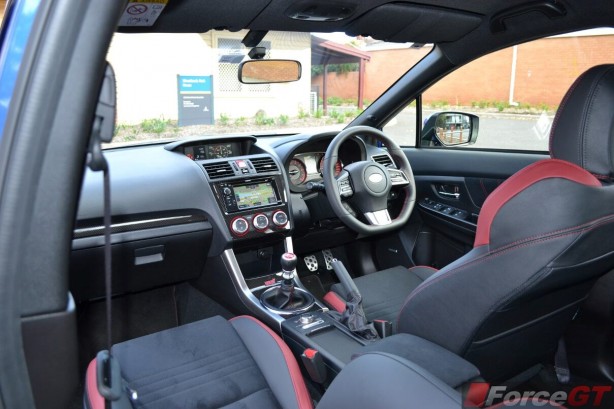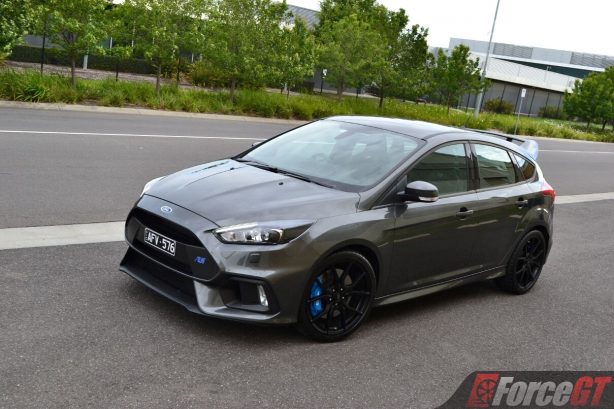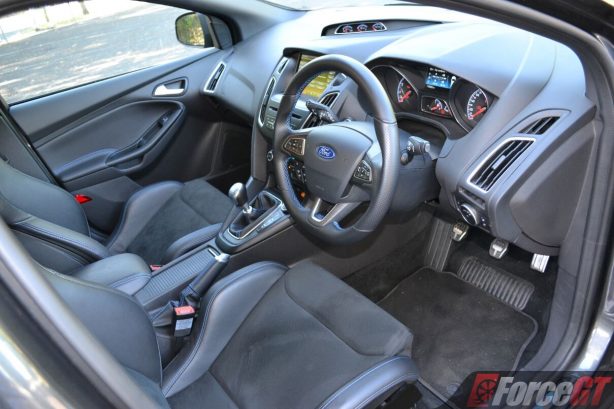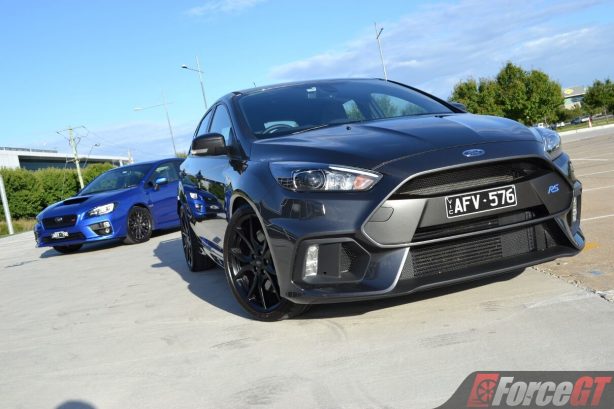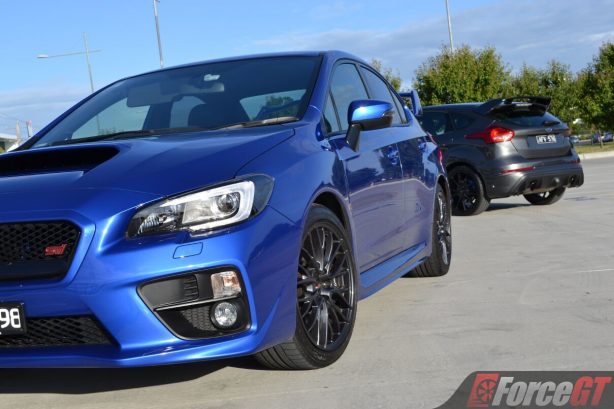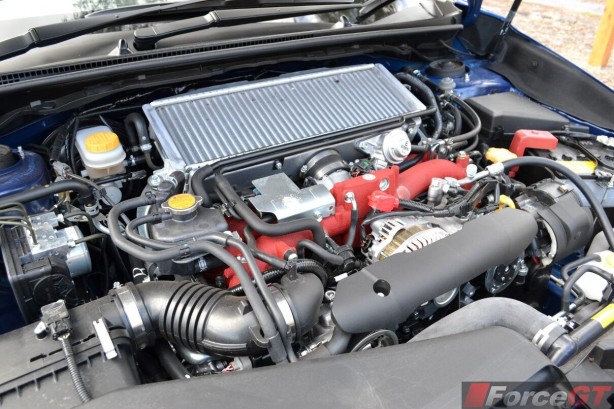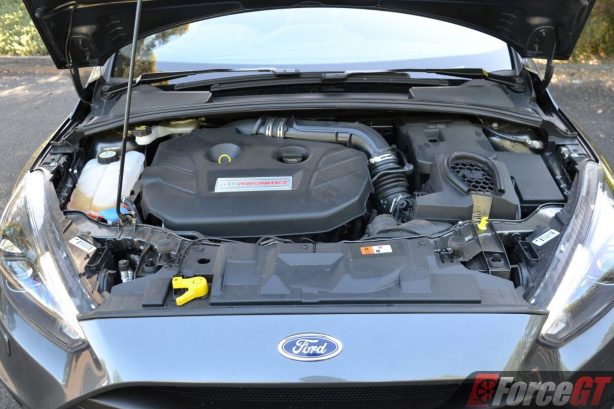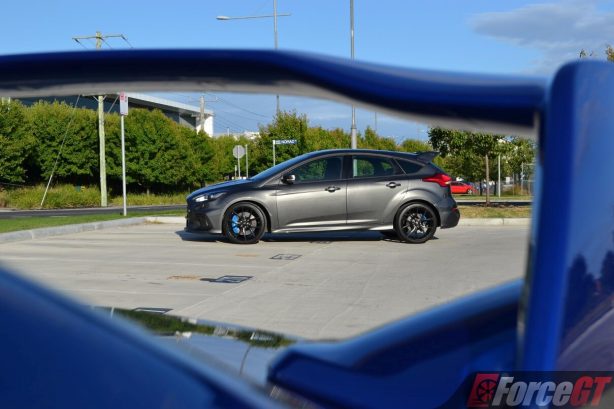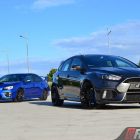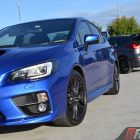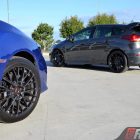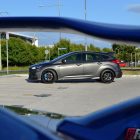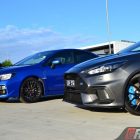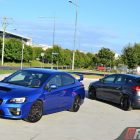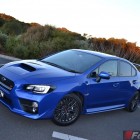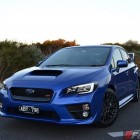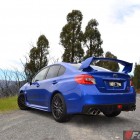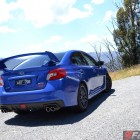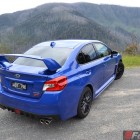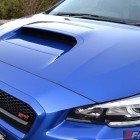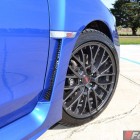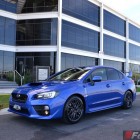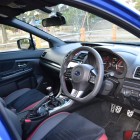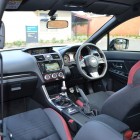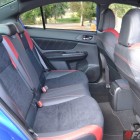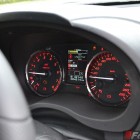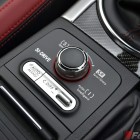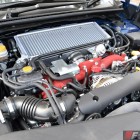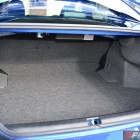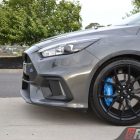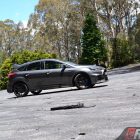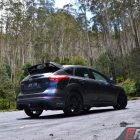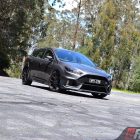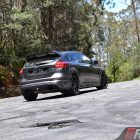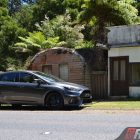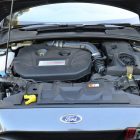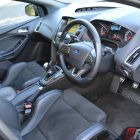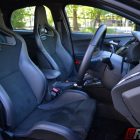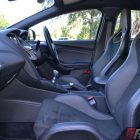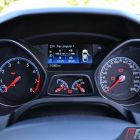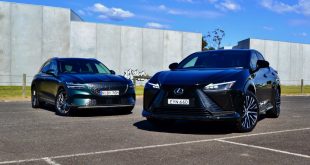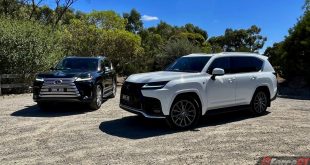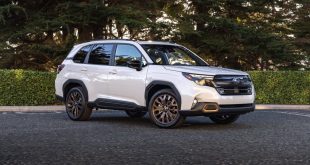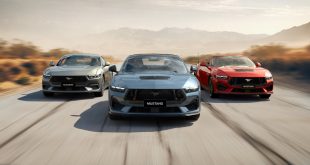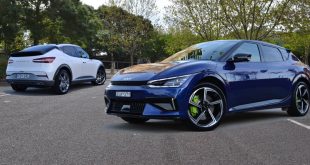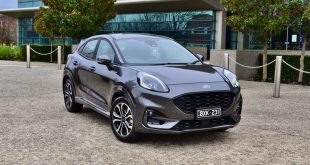Circa $50k turbocharged all-wheel drive performance can’t get any more hardcore than this pair. If you weigh performance and driving experience more than anything the Subaru WRX STI and Ford Focus RS are arguably the biggest grin makers this side of a Porsche Cayman S.
The WRX STI has always been one of our favourites. Pioneering the segment two decades ago with long-time rival Mitsubishi Lancer Evo, Subaru’s rally-bred performance icon has evolved into a more mature offering. And by that we mean improved refinement and comfort, part of Subaru’s strategy to pitch the STI to a wider demographic.
Priced from $49,790 plus on road costs, the WRX STI is a lot of bang for your buck. It packs a 2.5-litre turbocharged four-cylinder boxer engine channelling 221kW and 407Nm to all four wheels through a slick six-speed manual gearbox and Subaru’s renowned symmetrical all-wheel drive system.
On paper the 1,525kg Subie sprints from rest to 100km/h in 4.9 seconds, but unless you are willing to side step the clutch at 5,000rpm, realistically you will be looking at a time of around 5.2 seconds with a less brutal launch.
Like the Subaru, Ford’s Focus RS was honed in the tough battleground of rally racing. While its heritage in the gravel field might not be as rich as the STI, the Focus RS has become such a household name in the segment that it earned our honoured king of hot hatches status in our recent road test.
At $50,990 plus on-road costs the Focus RS is a shred more expensive than the STI but has more mouth-watering figures: 257kW of power and 440Nm of torque unleashed from a 2.3-litre four-cylinder engine boasting a twin-scroll turbocharger. As if that’s not enough power for a 1,575kg hatchback, an additional 30Nm is available for up to 15 seconds on transient overboost during hard acceleration.
Shuffled by an equally slick six-speed DIY box, the Focus RS knocks back the first 100km/h in just 4.8 seconds, time after time thanks to Launch Control. It’s simply mind-boggling for a five-door hatchback.
While both cars deliver ballistic acceleration and traction off the line, from the driver seat the experience isn’t quite the same. The RS boils much earlier than the STI, with peak torque available from just 1,600rpm and hangs on until 5,000rpm. There’s minimal turbo lag, which transforms every squeeze of the right pedal into a shove in the back and lots of forward thrust. It punches hard down low and pulls away effortlessly. Keep the throttle pinned and it’s quick to bounce off the limiter, though there’s not much in it in the last 500rpm.
Meanwhile, the STI packs all its bullets in the upper half of the rev range. It needs to be worked but when the fire power does come on above 4,000rpm it comes in full force. From here it’s a mad rush to the redline, pinning you back to your seat even more savagely than the RS. The sensation is nothing short of vicious, brutal even.
And because of this it’s more satisfying wringing out the STI than the RS on a track or when driving at the limit. Cruising around though, the RS is no doubt the friendlier of the pair thanks to a more linear power delivery.
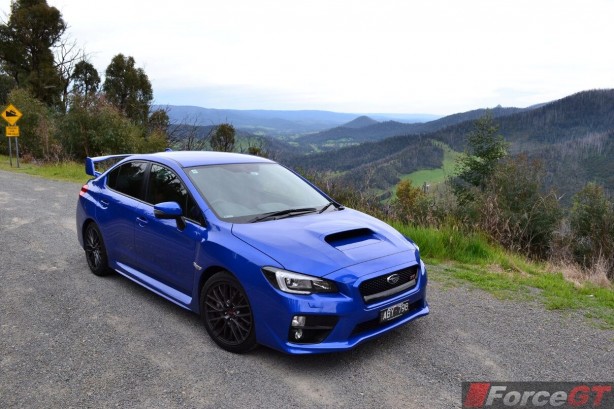
Both cars get big ticks for aural fireworks. The STI’s unmistakable boxer rumble under the bonnet is one of the most distinctive in the business, though some of that rawness, anti-social hard-edginess of its previous generations has been dialled out in the quest for wider acceptance. Fortunately that deep, bassy and appropriately metallic exhaust note from those quad-tips is still as solid as ever.
The new four-cylinder in the RS isn’t as evocative as the old five-pot but boy the way the exhaust pops, crackles and burbles on lift-off is as rebellious as you can get in a performance car. And we simply can’t have enough of it.
The STI’s all-wheel-drive system is the only full-time AWD in the segment (other than the ageing Mitsubishi Evo X). It boasts three differentials. A centre diff splits power front and rear and is capable of shuffling up to 80% of torque to either axle. Up the front a helical differential manages left/right torque transfer, while a Torsen LSD does the same to the rear axle. Banks of computers and sensors work to ensure torque is distributed to the correct places. But if you’re keen, the system also allows manual front/rear biasing of torque. Send everything to the back and the STI can even smoke the rear tyres in a four-wheel drift.
Subaru’s SI Drive system can vary throttle response through three selectable modes – Intelligent, Sport and Sport#, the former for more fuel efficient driving and the latter for circuit work, while Sport is ideal for spirited hill runs.
The STI’s turn in is super crisp and sharp. To pull it even quicker into the tightest or corner, there’s torque vectoring where the inside front wheel is braked and torque distributed to the outside wheel during hard cornering.
The RS is a front driver when the wheels are pointing straight at highway speeds. Its AWD system uses a vastly different approach than the STI though it, too, can divert as much as 70% of torque to the rear axle, or in Drift Mode (more on this later), to any one of the rear wheels.
The AWD hardware is made by GKN and is based on the company’s Twinster system, reengineered specifically for the RS. While the front axle is all conventional with an open differential and brake-based torque vectoring, the rear is quite unique. There isn’t a centre differential, so torque is sent to the rear differential from the front driveshafts through a propshaft. At the rear torque is distributed to each rear wheel independently through clutch packs, one on each driveshaft. The clutch packs also act as an LSD for the rear axle. There’s active torque vectoring – not brake-based – to get the outside rear agitated in tight cornering. And the final party trick? A rear axle that is geared 2% quicker than the front to kill understeer dead.
Despite the different approach in putting power down to the ground, both these cars are capable of tearing up corners at terrific speed with almost no body roll, hanging on to your intended line relentlessly, stringing apexes into a sustained, high-G indulgence.
The STI’s more mechanical AWD setup rewards drivers with a more tactile and connected driving feel. There is little barrier between you and the happenings underneath. You can feel the distribution of torque around the car and everything happens at a more gradual pace.
The steering is still a hydraulic system and rattles quite a lot on mid corner bumps but telegraphs every bit of information from the road to your palm. The Brembo stoppers offer plenty of bite and are wonderfully progressive and the pedals are perfectly placed for heel and toe.
Driving all four wheels at all times the STI grips hard through those brilliant Dunlop SP Sport MAXX RT tyres. It is a car that rewards smooth driving and doesn’t like to be rushed.
In the RS everything feels a tad less analogue but a few clicks sharper than the STI. Turn in is electrifyingly quick and the front end is even more locked down than the STI to the point it drives almost like a rear-biased AWD car. On the limit it feels less understeery than the STI, with a rear that is ever so willing to rotate and point the nose in your intended line.
The AWD system’s pre-emptive build-up of torque to the outside rear wheel as soon as you turn the wheel plays a large part in the RS’ understeer-free handling characteristic. The torque transfer, combined with the quicker rear axle literally ‘drive’ the RS into the bend.
Grip level from those Michelin Pilot Sport Cup 2 tyres is phenomenal. The electric steering is crisper than the STI and super sharp – just two turns lock-to-lock, though feedback doesn’t really start flowing in until lock is wound.
Like the STI the RS has good pedal placement for heel and toe and strong Brembo brakes that bite progressively right from the top of the pedal.
The RS can go sideways like the STI and way easier thanks to Drift Mode. When selected the AWD system can channel huge amount of torque to the outside rear wheel to induce on-throttle oversteer. Keep your foot pinned and it will maintain the slip angle by varying the torque split in the rear axle, turning expensive tyres into billowing cloud of smoke, all day long.
Both cars have very firm suspension but while the STI’s ride is still very much liveable in day-to-day driving the RS is just hanging on borderline acceptable, sniffing out every bit of road imperfections. Long drives in the Ford can quickly become tiresome, made worse by those thinly cushioned Recaro buckets. The Subaru on the other hand, with its cushier seats, is much more forgiving on long trips.
The RS with fuel saving tech such as idle stop/start and direct injection is, however, better at the bowser, averaging 8.1L/100km against the STI’s 10.4L/100km. Both cars slurp strictly on 98 Octane and the figures are rated average.
Visually, the STI is the more aggressive looking car of the pair. The trademark bonnet scoop and towering rear spoiler continue to define the new-gen STI’s shouty looks, though the latter can now be deleted at no cost for those who prefer to sneak under the radar a little, but not by much with its wide wheel fenders, chunky side skirts and beefed up bumpers.
The RS is just as eye-catching with its aggressive front bumper, massive roof spoiler, deep rear diffuser and striking black 19-inch wheels, though beefier side skirts and wider fenders would give the hot hatch even more attitude.
With four doors, both the RS and STI are practical performance cars, but being a sedan the Subaru has a bigger boot and longer wheelbase, which translates to better rear seat space than the Ford. The STI also has better forward visibility thanks to the thinner A pillar.
In terms of equipment both cars are generously equipped, arriving standard with keyless entry, dusk sensing LED headlights, LED brake lights, daytime running lights (DRL), reverse view camera, hill-start assist, dual zone climate control and satellite navigation. The Subaru does have a better sound system with that banging Harman Kardon stereo with eight speakers and a subwoofer compared to the Ford’s 9-speaker Sony system.
On the safety front, the STI gets 7 airbags, one more than the RS. Both cars are equipped with electronic stability control, anti-lock braking system and traction control.
Verdict
There is little that splits these two performance icons. The latest iterations of Subaru’s WRX STI and Ford’s Focus RS are still segment defining all-paw rocket ships packing giant-killing performance. Both are so focused on their performance that they are often forgiven for their lack of all-roundedness and complete disregard for the norm.
Despite as closely matched as they are there could only be one winner. The WRX STI is a more mechanical and pure package. Its drivetrain allows manual adjustability and in the wet it’s the more reassuring car. It offers immense level of dynamic fluidity and sheer pace on just about any type of road. It is also more practical and rides a little bit better on the rough stuff.
Meanwhile, the Focus RS feels as if it’s solely designed to go, stop and corner the quickest. It feels sharper, more locked down and nimbler, with brilliant adjustability and a clever all-wheel drive system that allows it to attack the bends at insane, almost physics defying speed. And if performance was the only language we speak, the RS is the new definition of all-paw rocket.
It is for these reasons that the WRX STI feels just a tad blunt in the company of the Focus RS. And it is for this the Ford takes the win.
2017 Subaru WRX STI | 2017 Ford Focus RS | |
| Design and Comfort: | 8.5 | 8.0 |
| Performance & Handling: | 9.0 | 9.5 |
| Economy: | 7.0 | 7.5 |
| Quality: | 8.5 | 8.0 |
| Features & Equipment: | 8.0 | 8.0 |
| Overall: |
2017 Subaru WRX STI Price and Specification
| Price (Excl. on-roads): | From $49,790 / As tested: $49,990 |
| Warranty: | 3 years/100,000km |
| Service Intervals: | 6 months/12,500km |
| Engine: | Turbocharged 2.5-litre horizontally-opposed 4-cylinder petrol (AWD) 221kW @ 6,000rpm; 407Nm @ 4,000rpm |
| Transmission | 6-speed manual |
| 0-100km/h | 4.9 seconds (claimed); 5.2 seconds (tested) |
| Fuel Consumption (Combined, L/100km): | Claimed: 10.4 / Tested: 12.0 |
| Body: | 4-door sedan; 5-seat |
| Safety: | 5-star ANCAP, 7 Airbags, Seatbelt pre-tensioners Front Seats, ABS, ESC, BA, EBD, Reversing Camera |
| Dimensions (L/W/H/W-B) mm: | 4,595/1,795/1,475/2,650 |
| Kerb Weight (kg) | 1,525 |
| Entertainment: | 7.0-inch Infotainment System, 8-speaker Harmon Karbon audio with Subwoofer, Satellite Navigation, Bluetooth, USB and AUX |
2017 Ford Focus RS Price and Specification
| Price (Excl. on-roads): | From $50,990 / As tested: $50,990 |
| Warranty: | 3 years/100,000km |
| Service Intervals: | 12 months/15,000km |
| Engine: | 2.3-litre turbocharged 4-cylinder petrol (AWD) 257kW @ 6,000rpm, 440Nm @ 1,600-5,000rpm |
| Transmission: | 6-speed manual |
| 0-100km/h | 4.8 seconds (tested) |
| Fuel Consumption (Combined, L/100km): | Claimed: 8.1 / Tested: 11.2 |
| Body: | 4-door hatch, 5-seat |
| Safety: | 5-star ANCAP, 6 airbags, ABS, EBD, BA, DSC, tyre pressure monitor, rear view camera, hill-start assist, parking sensors |
| Dimensions (L/W/H/W-B) mm: | 4,390/1,823/1,480/2,648 |
| Kerb Weight (kg) | 1,575 |
| Entertainment: | 8-inch high definition display, Satellite Navigation, Ford SYNC 2, 9-speaker, Bluetooth, USB and AUX |
Subaru WRX STI
Ford Focus RS
 ForceGT.com Car News, Car Reviews, Video Reviews, Tuning and much more.
ForceGT.com Car News, Car Reviews, Video Reviews, Tuning and much more. 